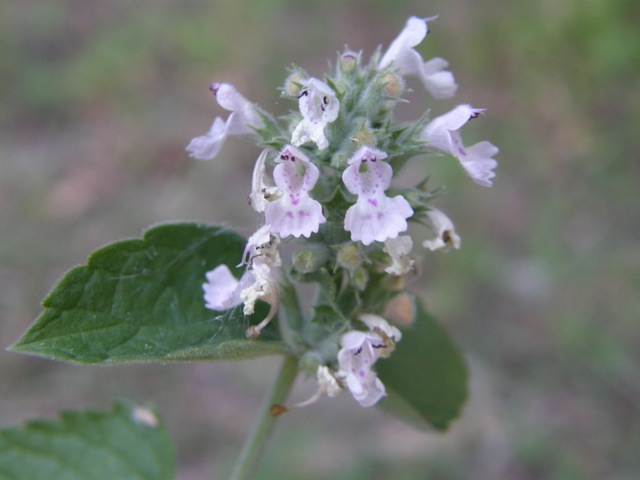Lamiaceae, the mint family.
Description:
Plant:
Erect, hairy/downy plant, 1'-3', with opposite, gray-green leaves and
terminal clusters of whitish or lavender flowers.
Flowers:
White or pale lavender, bilateral, about 1/2", with a large, scalloped,
lower lip, and purple spots. Five sepals, four stamens.
Leaves:
Opposite, triangular to heart-shaped (cordate), with coarse, rounded teeth.
Leaves are distinctly gray-green, and covered with soft down, especially
below and when new.
Fruit:
Four-seeded capsule common to all mints.
Blooming:
June-September
Habitat:
Waste areas, old farmyards and gardens.
Comments:
Introduced from Europe, and possibly originally native to Asia, catnip is
widely naturalized in North America, most commonly near inhabited or
formerly inhabited sites.
The plant is best known for its effect on domestic cats, who will roll
in it, chew it, run about, and generally act crazy and euphoric
for about 10 minutes, after which they
have little further interest until a few hours have passed.
The compound responsible is known as nepetalactone, and it is hypothesized
to activate a pheromone receptor, but since little is positively known about
the pheromonic life of cats, that is as far as the explanation goes.
There is some evidence that certain other cat species, e.g. lions, are
similarly affected.
There is no euphoric effect on people, though catnip tea is said to
be soothing.
Extracts of the leaves also repel insects, including mosquitoes, but are
not as effective as DEET when applied to the skin.
Where to find it:
I have found this in one spot, near the parking areas on the eastern boundary
of the park, presumably escaped from old gardens that were in the
area prior to the medical development.
